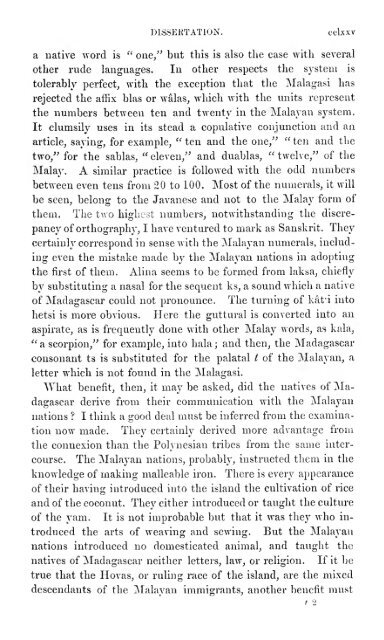A grammar and dictionary of the Malay language : with a preliminary ...
A grammar and dictionary of the Malay language : with a preliminary ...
A grammar and dictionary of the Malay language : with a preliminary ...
You also want an ePaper? Increase the reach of your titles
YUMPU automatically turns print PDFs into web optimized ePapers that Google loves.
DISSERTATION. cclxxv<br />
a native word is " one/' but this is also <strong>the</strong> case <strong>with</strong> several<br />
o<strong>the</strong>r rude <strong>language</strong>s. In o<strong>the</strong>r respects <strong>the</strong> system is<br />
tolerably perfect, <strong>with</strong> <strong>the</strong> exception that <strong>the</strong> Malagasi has<br />
rejected <strong>the</strong> affix bias or walas, which <strong>with</strong> <strong>the</strong> units represent<br />
<strong>the</strong> numbers between ten <strong>and</strong> twenty in <strong>the</strong> <strong>Malay</strong>an system.<br />
It clumsily uses in its stead a copulative conjunction <strong>and</strong> an<br />
article, saying, for example, " ten <strong>and</strong> <strong>the</strong> one,'' " ten <strong>and</strong> <strong>the</strong><br />
two," for <strong>the</strong> sablas, "eleven," <strong>and</strong> duablas, "twelve," <strong>of</strong> <strong>the</strong><br />
<strong>Malay</strong>. A similar practice is followed <strong>with</strong> <strong>the</strong> odd numbers<br />
between even tens from 20 to 100. Most <strong>of</strong> <strong>the</strong> numerals, it will<br />
be seen, belong to <strong>the</strong> Javanese <strong>and</strong> not to <strong>the</strong> I<strong>Malay</strong> form <strong>of</strong><br />
<strong>the</strong>m. The two highest numbers, not<strong>with</strong>st<strong>and</strong>ing <strong>the</strong> discrepancy<br />
<strong>of</strong> orthography, I have ventured to mark as Sanskrit. They<br />
certainly correspond in sense <strong>with</strong> <strong>the</strong> ^<strong>Malay</strong>an numerals, includ-<br />
ing even <strong>the</strong> mistake made by <strong>the</strong> <strong>Malay</strong>an nations in adopting<br />
<strong>the</strong> first <strong>of</strong> <strong>the</strong>m. Aliua seems to be formed from laksa, chiefly<br />
by substituting a nasal for <strong>the</strong> sequent ks, a sound which a native<br />
<strong>of</strong> Madagascar could not pronounce. The turning <strong>of</strong> kat'i into<br />
hetsi is more obvious. Here <strong>the</strong> guttural is converted into an<br />
aspirate, as is frequently done <strong>with</strong> o<strong>the</strong>r <strong>Malay</strong> words, as kala,<br />
" a scorpion," for example, into hala ; <strong>and</strong> <strong>the</strong>n, <strong>the</strong> INTadagascar<br />
consonant ts is substituted for <strong>the</strong> palatal t <strong>of</strong> <strong>the</strong> <strong>Malay</strong>an, a<br />
letter which is not found in <strong>the</strong> IMalagasi.<br />
What benefit, <strong>the</strong>n, it may be asked, did <strong>the</strong> natives <strong>of</strong> Ma-<br />
dagascar derive from <strong>the</strong>ir communication <strong>with</strong> <strong>the</strong> jNIalayan<br />
nations ? I think a good deal must be inferred from <strong>the</strong> examina-<br />
tion now made. They certainly derived more advantage from<br />
<strong>the</strong> connexion than <strong>the</strong> Polynesian tribes from <strong>the</strong> same inter-<br />
course. The <strong>Malay</strong>an nations, probably, instructed <strong>the</strong>m in <strong>the</strong><br />
knowledge <strong>of</strong> making malleable iron. There is every appearance<br />
<strong>of</strong> <strong>the</strong>ir having introduced into <strong>the</strong> isl<strong>and</strong> <strong>the</strong> cultivation <strong>of</strong> rice<br />
<strong>and</strong> <strong>of</strong> <strong>the</strong> coconut. They ei<strong>the</strong>r introduced or taught <strong>the</strong> culture<br />
<strong>of</strong> <strong>the</strong> yam. It is not improbable but that it was <strong>the</strong>y who introduced<br />
<strong>the</strong> arts <strong>of</strong> weaving <strong>and</strong> sewing. But <strong>the</strong> <strong>Malay</strong>an<br />
nations introduced no domesticated animal, <strong>and</strong> taught <strong>the</strong><br />
natives <strong>of</strong> jNIadagascar nei<strong>the</strong>r letters, law, or religion. If it be<br />
true that <strong>the</strong> Hovas, or ruling race <strong>of</strong> <strong>the</strong> isl<strong>and</strong>, are <strong>the</strong> mixed<br />
descendants <strong>of</strong> <strong>the</strong> jNIalayan immigrants, ano<strong>the</strong>r benefit must

















